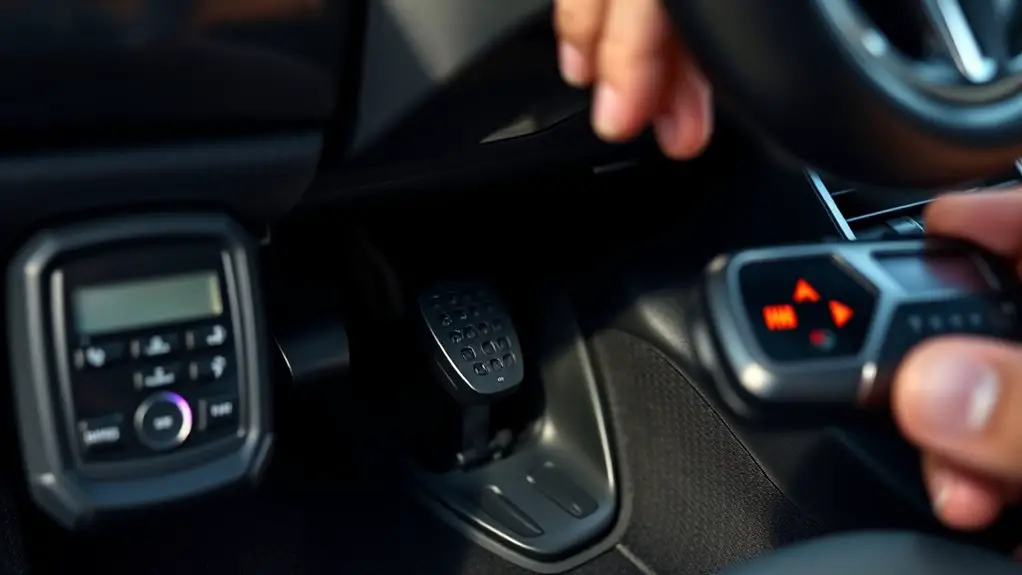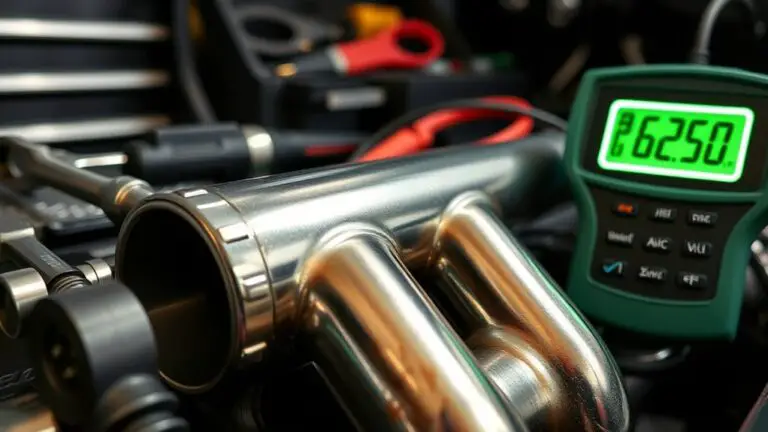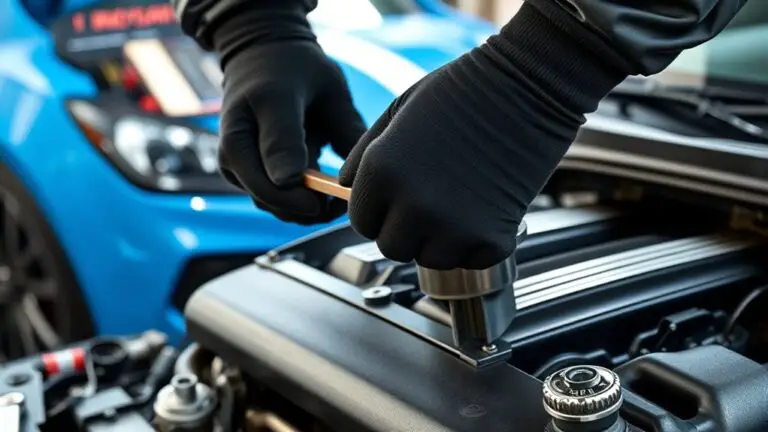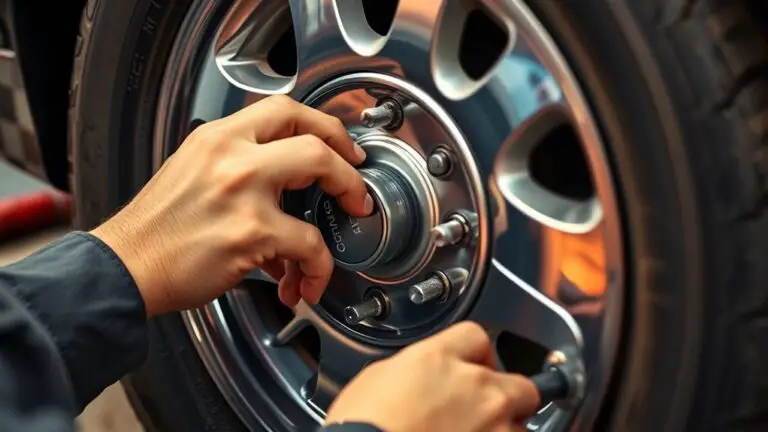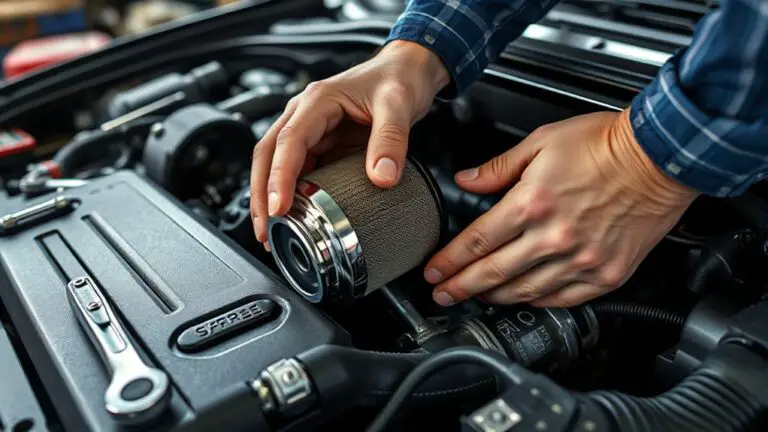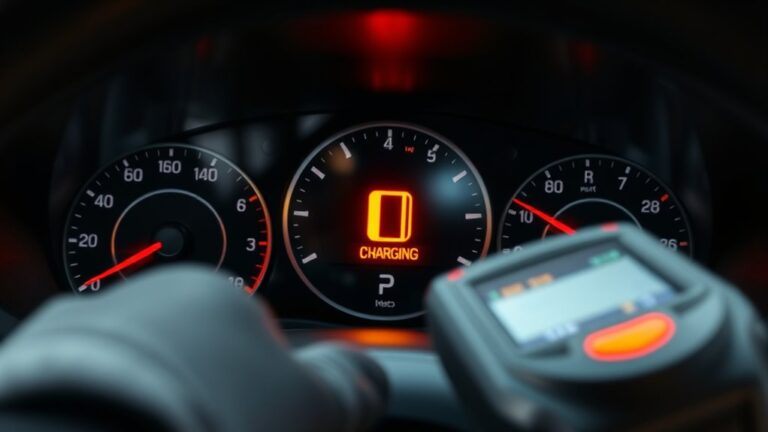How to Diagnose Soft Brake Pedal in Compact Car
To diagnose a soft brake pedal in your compact car, start by checking for air in the brake lines and look for leaks. Inspect the brake fluid level and quality; dark or cloudy fluid indicates contamination. Test the master cylinder for consistent pressure and perform a pump test. Evaluate the brake pads and rotors for wear, and investigate the brake booster for vacuum leaks. Addressing these areas can help identify the underlying issue effectively, and there’s more to explore.
Understanding the Brake System Components
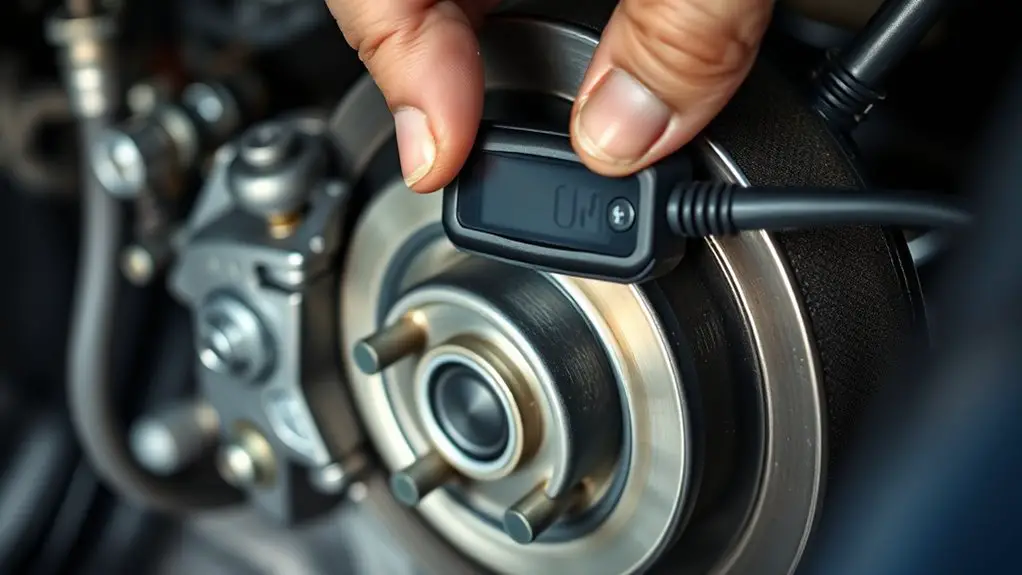
Understanding the brake system components is essential for diagnosing issues like a soft brake pedal. Different brake system types, primarily hydraulic systems, rely on specific components working in unison. The master cylinder converts your foot’s force into hydraulic pressure, sending brake fluid through lines to the calipers. Here, hydraulic principles come into play, as this fluid exerts pressure on the brake pads against the rotors, slowing down the vehicle.
Key components include the brake booster, which amplifies the force applied to the master cylinder, and the brake lines, which must be free of leaks to maintain pressure. Familiarizing yourself with these elements lets you assess the system’s integrity effectively. If you understand how each component interacts, you gain insight into potential failures that might contribute to a soft brake pedal, enabling you to take informed steps toward resolution.
Common Causes of a Soft Brake Pedal
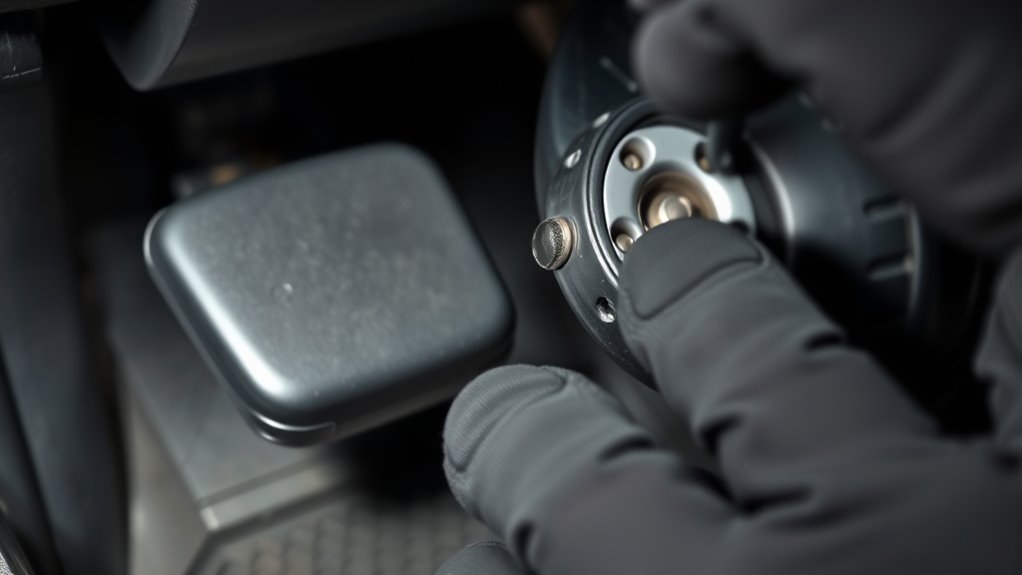
If you notice a soft brake pedal, several underlying issues could be at play. One common cause is a fluid leak within the brake system. This can lead to insufficient hydraulic pressure, rendering your brake pedal less responsive. Another possibility is worn brake components, such as pads or rotors, which can affect the overall braking efficiency. Additionally, a malfunctioning master cylinder may fail to create the necessary pressure, resulting in a soft diagnosis.
You might also face issues related to the brake booster, which could compromise the vacuum necessary for effective braking. Finally, contaminated brake fluid can introduce air or moisture into the system, further decreasing pedal firmness. Addressing these issues promptly is essential for maintaining peak braking performance and ensuring your safety on the road. Being aware of these common causes allows you to take proactive steps in diagnosing and resolving the soft brake pedal issue.
Checking for Air in the Brake Lines
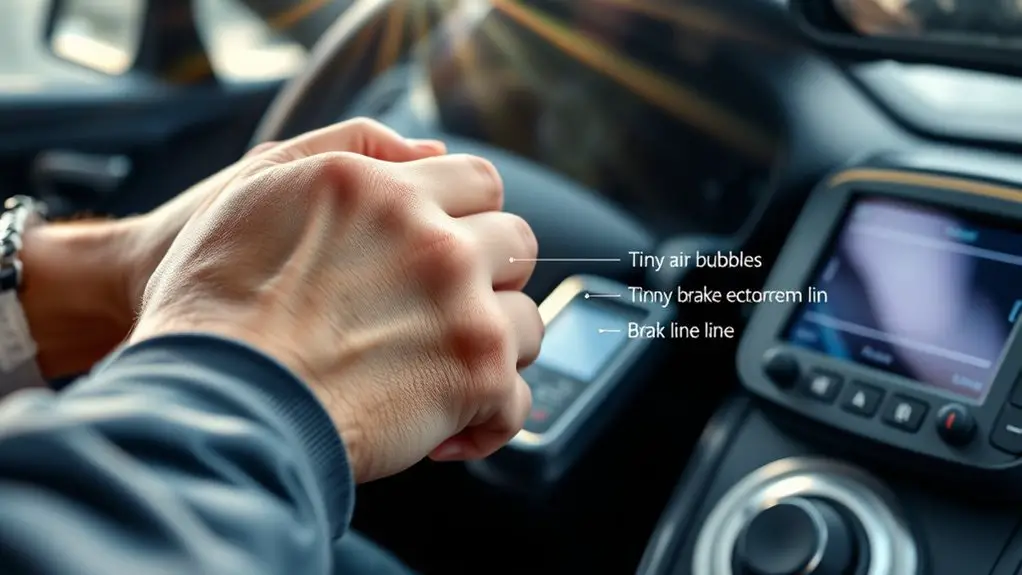
To check for air in the brake lines, start with a thorough visual inspection of the lines and fittings for any signs of leaks or damage. If you detect air, bleeding the brake lines is crucial to restore proper hydraulic pressure and brake performance. This process will help guarantee that any trapped air is expelled, allowing for a firmer brake pedal feel.
Visual Inspection Process
A thorough visual inspection is vital for diagnosing a soft brake pedal, particularly when checking for air in the brake lines. Start by examining the brake lines for any signs of leaks, cracks, or damage. Look for fluid pooling under the car, as this can indicate a breach. Check the brake master cylinder for any signs of fluid loss or contamination. Confirm all fittings and connections are secure and free of corrosion. Pay attention to the condition of the brake pads and rotors, as their wear can affect pedal feel. If you spot any issues during your inspection, it’s important to address them before proceeding with further diagnostic steps to guarantee maximum braking performance.
Bleeding the Brake Lines
While air in the brake lines can considerably compromise braking efficiency, bleeding the lines is essential to restore proper pedal feel. Start by ensuring you’re equipped with the necessary tools for effective brake line maintenance. Locate the bleeder valves on each brake caliper, then use air removal techniques to eliminate trapped air. Have an assistant pump the brake pedal to build pressure, then open the valve to release fluid and air. Close the valve before your assistant releases the pedal. Repeat this process until the brake fluid runs clear and free of bubbles. Remember, maintaining proper brake fluid levels is vital during this process. Once complete, test the pedal feel—properly bled lines should yield a firm, responsive brake pedal.
Inspecting the Brake Fluid Level and Quality
Before diving deeper into diagnosing a soft brake pedal, you should first inspect the brake fluid level and quality, as they play an important role in the overall braking system’s performance. Start by checking the fluid reservoir; a low level can indicate a leak or worn components. Make sure you’re aware of the different brake fluid types—DOT 3, DOT 4, and DOT 5—as compatibility is essential for ideal function. Next, assess the fluid’s quality by examining its color and clarity. Fresh fluid is typically clear or light amber, while dark or cloudy fluid suggests contamination. It’s also critical to check viscosity; thick or syrupy fluid can hinder performance and may require a complete flush. By confirming both the level and quality of your brake fluid, you can rule out these issues before moving on to more complex diagnostics.
Testing the Master Cylinder Functionality
Testing the master cylinder functionality is essential in diagnosing a soft brake pedal, as this component directly influences brake pressure. Start by checking for common master cylinder symptoms, such as fluid leaks or a spongy pedal feel. You can employ several testing methods to evaluate its performance. One effective approach is to perform a “pump test”: repeatedly pump the brake pedal and observe if it firms up after several pumps. If it doesn’t, the master cylinder may be failing. Additionally, you can use a pressure gauge to measure the pressure output; it should remain consistent. Inspect for internal leaks by blocking the brake lines and checking for pedal drop. If the pedal sinks, the master cylinder likely has internal damage. By systematically testing these aspects, you can pinpoint whether the master cylinder is the culprit behind the soft brake pedal issue.
Evaluating the Brake Pads and Rotors
When evaluating the brake pads and rotors, it’s essential to inspect their condition, as wear and damage can greatly affect braking performance. Start by checking the brake pads for any signs of wear. If you notice a thickness of less than 1/4 inch, it’s time for replacement. Uneven brake pad wear can indicate issues with calipers or alignment, so take note of any irregularities.
Next, assess the rotor condition. Look for grooves, cracks, or warping; these defects can lead to reduced contact area, compromising braking efficiency. A smooth, even surface is vital for peak performance. If the rotors show significant wear, resurfacing or replacement may be necessary.
Investigating the Brake Booster
To assess the brake booster, you should first check its functionality by testing the pedal feel with the engine on and off. Next, inspect for any vacuum leaks that could impair performance, as even small leaks can greatly affect braking response. Finally, evaluate the condition of the booster diaphragm, as damage here can lead to a soft brake pedal and reduced braking efficiency.
Brake Booster Functionality Check
A thorough brake booster functionality check is crucial for diagnosing a soft brake pedal, as this component plays an essential role in amplifying the force applied to the brake pedal. To investigate the brake booster, you should:
- Inspect for leaks: Look for any signs of fluid escaping from the booster.
- Check the vacuum source: Verify the vacuum line is intact and correctly connected.
- Test the pedal feel: With the engine off, press the brake pedal; it should feel firm. Start the engine, and the pedal should sink slightly.
- Identify brake booster types: Know whether you have a diaphragm or dual-stage booster, as this influences replacement procedures.
If the booster fails these tests, consider a brake booster replacement to restore proper function.
Vacuum Leak Inspection
Inspecting for vacuum leaks is crucial in diagnosing a soft brake pedal, as even a small leak can greatly impair brake performance. Start by visually examining the brake booster and its associated hoses for any signs of wear, cracks, or disconnections. A vacuum leak can lead to insufficient pressure in the brake booster, resulting in a spongy feel when you press the pedal. You can use a smoke machine to identify leaks, or simply spray a small amount of brake cleaner around the booster while the engine runs; if the idle changes, you’ve found your leak. Address any identified vacuum leaks promptly to restore ideal brake performance and guarantee your safety on the road.
Booster Diaphragm Condition
After checking for vacuum leaks, the next step is examining the condition of the brake booster diaphragm. A compromised diaphragm can lead to a soft brake pedal, impacting your vehicle’s braking performance. Here’s what you should look for:
- Visual Cracks: Inspect for any visible tears or cracks on the diaphragm.
- Surface Contamination: Check for oil or fluid that may have contaminated the diaphragm.
- Punctured Areas: Verify there are no punctures, which can drastically affect function.
- Response Test: Perform a brake pedal test; a hard pedal indicates diaphragm issues.
Regular brake booster maintenance is vital, and if you find any damage, consider diaphragm replacement to restore peak braking performance and enhance your driving freedom.
When to Seek Professional Help
When you’ve exhausted basic troubleshooting methods and the soft brake pedal persists, it is essential to seek professional help. Ignoring signs of malfunction can compromise your safety and freedom on the road. Professional services can identify underlying issues that you may not have the tools or expertise to detect.
| Signs of Malfunction | Action Needed |
|---|---|
| Spongy or soft pedal | Immediate inspection required |
| Uneven braking response | Diagnostic scan recommended |
| Fluid leaks under the vehicle | Urgent professional intervention |
Don’t risk your safety by delaying necessary repairs. A qualified technician can analyze your braking system, offering insights that guarantee your compact car performs at its best. Remember, prioritizing your vehicle’s health enhances your driving experience and sustains your independence. Trust the experts to restore your peace of mind and keep your journey smooth.
Frequently Asked Questions
Can a Soft Brake Pedal Affect My Car’s Overall Performance?
Yes, a soft brake pedal can seriously affect your car’s overall performance. It often indicates issues like low brake fluid or air in the brake lines, which can compromise brake efficiency and increase stopping distances. This decreased pedal feel can lead to a lack of confidence while driving, as you may not respond effectively in emergencies. To maintain your vehicle’s performance and safety, it’s essential to address any softness in the brake pedal promptly.
How Often Should I Check My Brake System?
You should check your brake system at least every six months for peak performance. Regular inspections help identify issues early and guarantee safety. As part of your brake maintenance tips, look for any signs of wear, such as unusual noises or a soft pedal. If you drive frequently or in harsh conditions, consider increasing the inspection frequency. Staying proactive can save you from costly repairs and enhance your driving freedom.
What Are the Signs of Worn Brake Pads?
You’d think worn brake pads would announce themselves with a marching band, but they’re sneakier than that. Warning signs include squeaking or grinding noises when you brake, a vibrating brake pedal, or a longer stopping distance. If you notice a soft brake pedal, it might also indicate brake pad issues. Staying alert to these subtle hints can keep you safe and let you enjoy the freedom of the road without unexpected stops.
Is It Safe to Drive With a Soft Brake Pedal?
No, it’s not safe to drive with a soft brake pedal. This condition often indicates issues like low brake fluid or air in the brake lines, leading to insufficient pedal pressure. Without proper pressure, your ability to stop could be compromised, increasing the risk of an accident. Prioritize your safety and check your brake fluid level or consult a professional to address the problem before hitting the road again.
How Can Weather Conditions Impact Brake Performance?
Weather conditions can greatly impact brake performance due to temperature effects on brake fluid. In colder temperatures, brake fluid can thicken, leading to a sluggish response, while high heat can cause it to vaporize, resulting in air bubbles that compromise braking efficiency. You should regularly check and replace your brake fluid, especially during extreme weather, to guarantee consistent performance and maintain your freedom on the road. Stay proactive for a safe driving experience.

